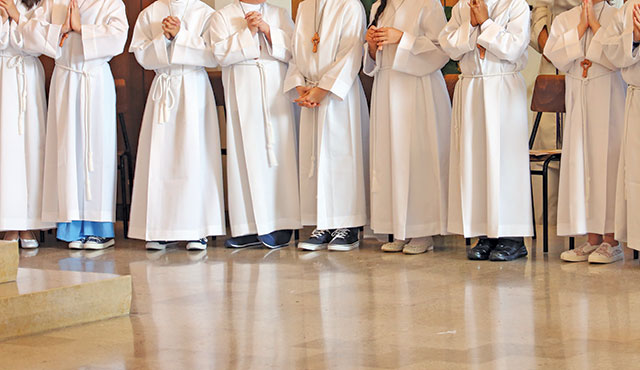With four or more altar servers required at each Mass, it isn’t unusual for a Catholic parish to have 50-100 trained servers on the roster.
In the Diocese of Orange, about 50 percent of the altar servers are female. The Vatican decided to permit females to serve at the altar in March 1994.
“Our bishops have allowed girls to serve since it was first a possibility,” notes Lesa Truxaw, Director of the Diocesan Office For Worship. Granted, she adds, “changes that affect culture take a while for some and having women in the sanctuary was a big change.”
With papal recognition, there was no impediment to girls serving at the Mass. “As soon as women could serve, the balance of who we are as people of God could be seen and experienced.”
Interestingly, Catholics still debate the issue of girls serving at the altar. Because altar service is considered by many the first step in the acolyte process – and the priesthood is exclusively male – some argue that girls don’t belong.
Conversely, many believe that altar service must be open to a diverse population, as are the Eucharistic, lector, and other ministries, mirroring the many races, ethnicities, and languages that comprise our parish families.
Altar service is a key tool in getting children involved in the Mass. “The way to get kids and teens to take ownership of their faith is to give them responsibility, and altar serving does just that,” says Mary Kathleen Cahill, writing in U.S. Catholic in January 2015.
“When girls are barred from serving at the altar, they miss out on an important part of faith formation—and the church does, too.”
Truxaw says Orange County’s altar servers range from third-graders to college students, but adults and children do not serve together. Each parish develops its own training or mentorship plan, and guidebooks from Catholic publishers are available to develop training curricula. New servers often observe the Mass from the sanctuary to familiarize themselves with procedure.
“Because the Mass is celebrated differently in each parish, training will vary by parish, but basically they will go through the order of the Mass to understand what happens when, especially during the celebration of the Eucharist,” Truxaw explains. “They cover how and when to approach the altar and the appropriate signs of reverence in each parish.”
For example, in some parishes servers stand with their hands together at chest level, fingertips pointed upward. In other parishes servers intertwine their fingers.
Altar service is a wonderful way for children to learn more about the Mass. “When you are serving, you learn at a very deep level what’s happening when,” she says. “When you are in charge of an activity, all of a sudden you are more attuned to detail. Those details lead to deeper prayer.”
She says a growing number of children, male and female alike, want to be involved in liturgy. “They get that it matters, and they want to contribute their gifts.”

